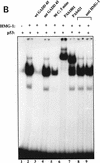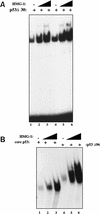High mobility group protein-1 (HMG-1) is a unique activator of p53
- PMID: 9472015
- PMCID: PMC316524
- DOI: 10.1101/gad.12.4.462
High mobility group protein-1 (HMG-1) is a unique activator of p53
Abstract
The binding of p53 protein to DNA is stimulated by its interaction with covalent as well as noncovalent modifiers. We report the identification of a factor from HeLa nuclear extracts that activates p53 DNA binding. This factor was purified to homogeneity and identified as the high mobility group protein, HMG-1. HMG-1 belongs to a family of highly conserved chromatin-associated nucleoproteins that bend DNA and facilitate the binding of various transcription factors to their cognate DNA sequences. We demonstrate that recombinant His-tagged HMG-1 enhances p53 DNA binding in vitro and also that HMG-1 and p53 can interact directly in vitro. Unexpectedly, HMG-1 also stimulates DNA binding by p53Delta30, a carboxy-terminally deleted form of the protein that is considered to be constitutively active, suggesting that HMG-1 stimulates p53 by a mechanism that is distinct from other known activators of p53. Finally, using transient transfection assays we show that HMG-1 can increase p53 and p53Delta30-mediated transactivation in vivo. HMG-1 promotes the assembly of higher order p53 nucleoprotein structures, and these data, along with the fact that HMG-1 is capable of bending DNA, suggest that HMG-1 may activate p53 DNA binding by a novel mechanism involving a structural change in the target DNA.
Figures











Similar articles
-
High-mobility group chromatin proteins 1 and 2 functionally interact with steroid hormone receptors to enhance their DNA binding in vitro and transcriptional activity in mammalian cells.Mol Cell Biol. 1998 Aug;18(8):4471-87. doi: 10.1128/MCB.18.8.4471. Mol Cell Biol. 1998. PMID: 9671457 Free PMC article.
-
The DNA-bending protein HMG-1 enhances progesterone receptor binding to its target DNA sequences.Mol Cell Biol. 1994 May;14(5):3376-91. doi: 10.1128/mcb.14.5.3376-3391.1994. Mol Cell Biol. 1994. PMID: 8164686 Free PMC article.
-
HMG-1 stimulates estrogen response element binding by estrogen receptor from stably transfected HeLa cells.Mol Endocrinol. 1999 Apr;13(4):632-43. doi: 10.1210/mend.13.4.0264. Mol Endocrinol. 1999. PMID: 10194768
-
HMG domain proteins: architectural elements in the assembly of nucleoprotein structures.Trends Genet. 1994 Mar;10(3):94-100. doi: 10.1016/0168-9525(94)90232-1. Trends Genet. 1994. PMID: 8178371 Review.
-
Nuclear accessory factors enhance the binding of progesterone receptor to specific target DNA.J Steroid Biochem Mol Biol. 1994 Jan;48(1):1-13. doi: 10.1016/0960-0760(94)90245-3. J Steroid Biochem Mol Biol. 1994. PMID: 8136295 Review.
Cited by
-
Dial 9-1-1 for p53: mechanisms of p53 activation by cellular stress.Neoplasia. 2000 May-Jun;2(3):208-25. doi: 10.1038/sj.neo.7900073. Neoplasia. 2000. PMID: 10935507 Free PMC article. Review.
-
Senescent cells as a source of inflammatory factors for tumor progression.Cancer Metastasis Rev. 2010 Jun;29(2):273-83. doi: 10.1007/s10555-010-9220-9. Cancer Metastasis Rev. 2010. PMID: 20390322 Free PMC article. Review.
-
Y box-binding protein-1 binds preferentially to single-stranded nucleic acids and exhibits 3'-->5' exonuclease activity.Nucleic Acids Res. 2001 Mar 1;29(5):1200-7. doi: 10.1093/nar/29.5.1200. Nucleic Acids Res. 2001. PMID: 11222770 Free PMC article.
-
The role of cell death in the pathogenesis of autoimmune disease: HMGB1 and microparticles as intercellular mediators of inflammation.Mod Rheumatol. 2008;18(4):319-26. doi: 10.1007/s10165-008-0054-z. Epub 2008 Apr 17. Mod Rheumatol. 2008. PMID: 18418695 Free PMC article. Review.
-
Peptide-protein interactions suggest that acetylation of lysines 381 and 382 of p53 is important for positive coactivator 4-p53 interaction.J Biol Chem. 2011 Jul 15;286(28):25076-87. doi: 10.1074/jbc.M110.205328. Epub 2011 May 17. J Biol Chem. 2011. PMID: 21586571 Free PMC article.
References
-
- Agarwal A, Schatz DG. RAG1 and RAG2 form a stable postcleavage synaptic complex with DNA containing signal ends in V(D)J recombination. Cell. 1997;89:43–53. - PubMed
-
- Bazett-Jones DP, LeBlanc B, Herfort M, Moss T. Short-range DNA looping by the Xenopus HMG-box transcription factor, xUBF. Science. 1994;264:1134–1137. - PubMed
Publication types
MeSH terms
Substances
Grants and funding
LinkOut - more resources
Full Text Sources
Other Literature Sources
Molecular Biology Databases
Research Materials
Miscellaneous
